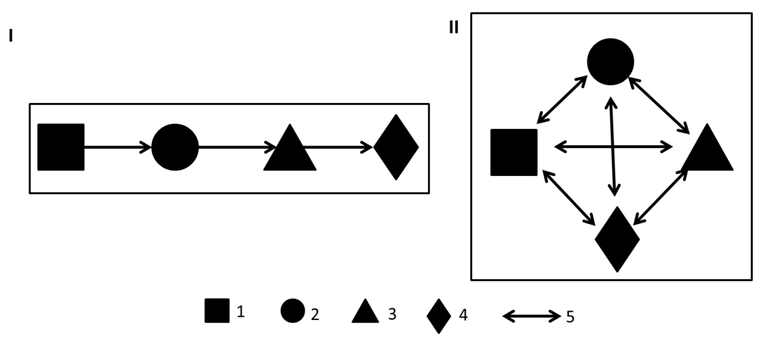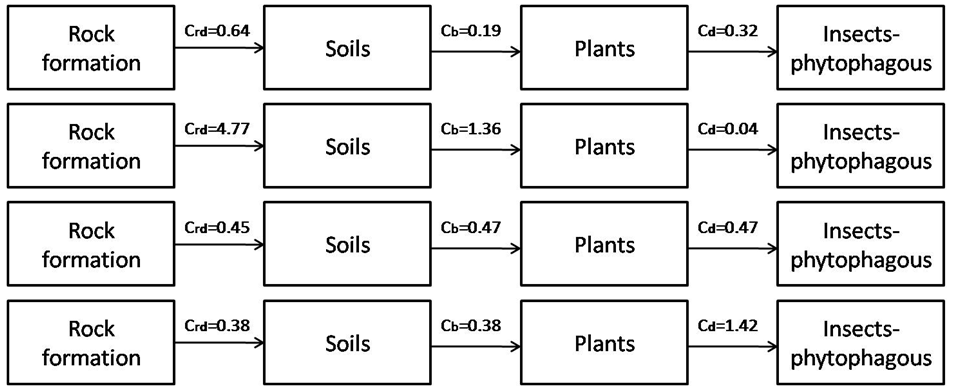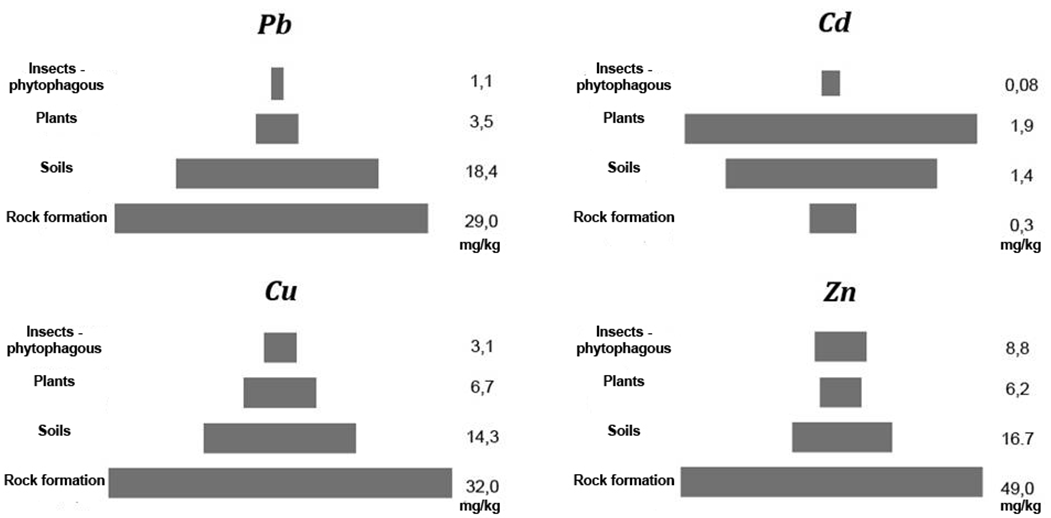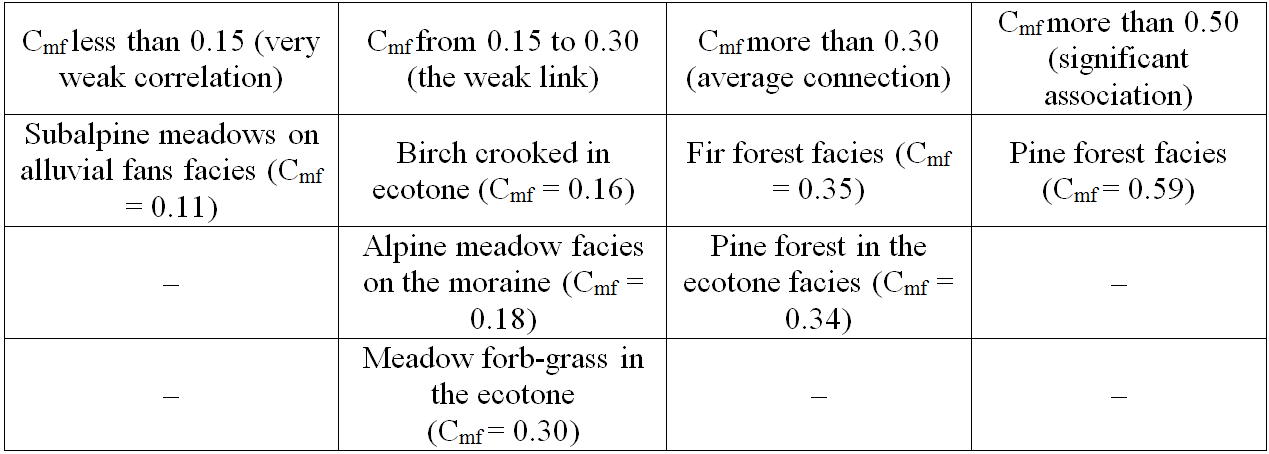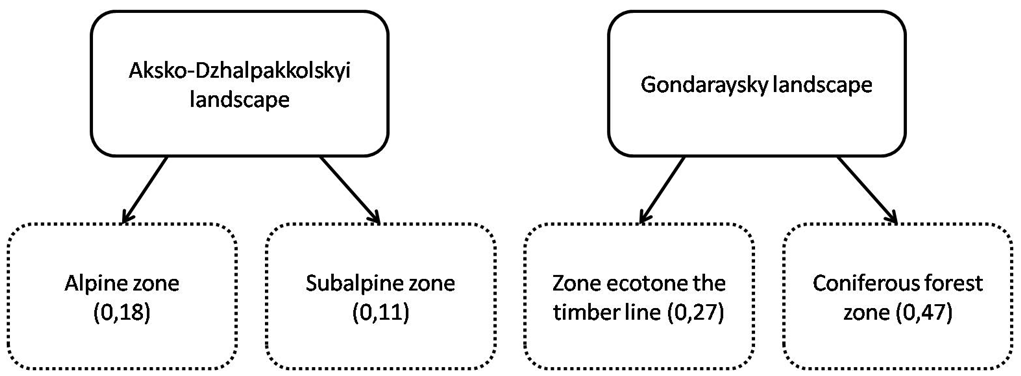ПРОБЛЕМЫ ВЗАИМОДЕЙСТВИЯ КОМПОНЕНТОВ ФАЦИЙ ГОРНЫХ ЛАНДШАФТОВ КАРАЧАЕВО-ЧЕРКЕССКОЙ РЕСПУБЛИКИ
Сивоконь Ю.В.1, Лошаков А.В.2, Шевченко Д.А.3
1Кандидат географических наук, 2Кандидат сельскохозяйственных наук, 3Кандидат сельскохозяйственных наук, Ставропольский государственный аграрный университет
ПРОБЛЕМЫ ВЗАИМОДЕЙСТВИЯ КОМПОНЕНТОВ ФАЦИЙ ГОРНЫХ ЛАНДШАФТОВ КАРАЧАЕВО-ЧЕРКЕССКОЙ РЕСПУБЛИКИ
Аннотация
Рассмотрены особенности применения геохимического подхода в изучении взаимодействия компонентов фаций, их основных видов в пределах горных ландшафтов. Сформулирован и обоснован понятийный аппарат, касающийся геохимических закономерностей взаимосвязей фациальных образований.
Ключевые слова: горный ландшафт, фация, геохимические условия, межкомпонентные связи.
Sivokon Yu.V.1, Loshakov A.V.2, Shevchenko D.A.3
1Candidate of Geographical Sciences, 2Candidate of Agricultural Sciences, 3Candidate of Agricultural Sciences, Stavropol State Agrarian University
PROBLEMS OF INTERACTION BETWEEN COMPONENTS FACIES OF MOUNTAIN LANDSCAPES KARACHAY-CHERKESS REPUBLIC
Abstract
The features of the application of geochemical approach to the study of the interaction of components facies, their main species in mountain landscapes. Formulate and justify the conceptual apparatus relating to the laws of geochemical facies relationships formations.
Keywords: mountains, facies and geochemical conditions, Interconnects connection.
The landscape is a complex natural formation consisting of a plurality of components, combined into one real-power communications and information. Systemically important role in the landscape play a certain correlation and dependency when interacting components mutually influence each other [4]. Carrying out geochemical studies of such relationships, the study of their dynamics, allow us to predict any changes in the functioning of natural systems, as well as stability to external influences. This study is relevant because in the strategy of innovative development of the Russian Federation for the period up to 2020 a lot of attention paid to environmental performance [1]. A particularly important role is played by mountain landscapes which have a low degree of self-organization and particularly sensitive to human disturbance [8].
The most expedient to study the interaction of the components at the level facies, is the smallest morphological landscape units, with the closest relationship between the components of different levels of organization of matter (bioinert, abiotic and biotic). The integrity of the facial Geosystems provides sufficient internal migration close ties. This narrowness of these bonds are more stable than between adjacent facies geosystems [9; 2].
Facies approach allows us to study the structure-states (in this case, linear and geosystem), reflecting the geochemical characteristics of natural conditions. The device facies are most conveniently studied on the example of models: linear and geosystem (integral) (Fig. 1).
Fig. 1 - facies models [5]
I - linear; II - geosystem;
1,2,3 - abiotic components; 4 - biotic (biological) components; 5 - communication interconnects
These models, having a similarity set of elements and relationships are significantly different intra-oriented relations.
Empirical research phase interconnect bonds held within the framework of the Western Caucasus, on the territory of the Republic of Karachay-Cherkessia, within two landscapes - Gondarayskyi and Aksko-Dzhalpakkolskyi, which were formed in the river valleys.
Specificity geochemical conditions was studied using a linear model, reflecting the twin vertical connections between the components in the space of coherent geochemical facies in Chains rocks → soil (coefficient of radial differentiation Crd); soil → plants (coefficient of biological absorption Cb) [6]; plant → insect herbivores (coefficient of discrimination Cd) [3].
As an example, Figure 2 shows the linear model of redistribution of elements in facies of pine forests on the mountain-forest brown soils slope trough valleys, folded colluvium (Fig. 2).
Fig. 2 - The coefficients of serial distribution of paired relationships of components in the facies of the Gondarayskyi’s landscape of pine forests
This linear distribution ensures a particularly natural conditions and geochemical environment that is conducive to the migration of chemical elements in the spatial structure of facies, which allows to approach the understanding of such an important concept in the theory of landscape as geochemical conditions. Their features make it possible to understand how a geochemical facies and structure prevailing in her cause and effect relationships.
The facies Gondarayskyi’s landscape of pine forests in the soil scattered component lead (Crd = 0.64), copper (Crd = 0.45), and zinc (Crd = 0.34) and intensively accumulate cadmium (Crd = 4.77). This trend continues with further movement of the geochemical chain, but the coefficients of biological absorption decreased in comparison with the coefficients of the radial differentiation of lead (Cb = 0.19) and cadmium (Cb = 1.36). By virtue of large concentrations in the soil, cadmium continues to accumulate in plants.
When migrating from a plant component in invertebrate organisms factors of discrimination such as cadmium cell are reduced, will remain the same from copper and lead have increased. Thus, these elements undergo seizure. Only the zinc begins to accumulate in invertebrate organisms in comparison with the plant components (Cd = 1.42).
At the same time, patterns in the redistribution of elements can be identified by the example diagrams of geochemical facies of matter in space. These diagrams are constructed for example facies pine forests dominant forest belt studied landscape (Fig. 3).
Fig. 3 - Geochemical diagrams redistribution of elements in the components facies pine forests dominant forest belt
Most often, the dependence becomes linear, with a gradual decrease in the concentration of elements in the gradual transition from their abiotic components to biotic (from simple to complex) and the transformation of the physical processes in biochemistry. At the same time, there are abnormalities associated with biogeochemical specialization plants or anthropogenic impact on the landscape. The pyramidal structure of the geochemical diagrams showing the redistribution of elements from the source rock to phytophages. Such a structure is consonant with the law of the pyramid energies R. Lindemann [7].
When using a multifactor model geosystem possible to carry out the correlation analysis, which determines the structure of the geochemical landscape as a condition resulting from multivariate relationships and ambiguous behavior of all components. Here we have to deal with multifactorial dependencies that characterize the sustainability of the facies and its natural conditions and, therefore, reflect the stability of the relationship, and that can not be traced with the help of only paired correlation coefficients. Multivariate correlation magnitude can vary from 0 to 1.
Multifactor correlation coefficients on the content of chemical elements in the components for different types of facies (Cmf) and high-altitude zones are shown in Table 1 and Fig. 4.
Table 1 – Multiple correlation coefficients and stable relations of components and facies Gondarayskiy’s and Aksko-Dzhalpakkolskyi’s landscapes
Indicators of multiple correlation interconnect links in the facies of mountain landscapes are relatively small and do not exceed 0.59, but they allow to follow certain patterns and peculiarities in the formation of geochemical conditions. Most weakened links between components in a sub-alpine vegetation facies (Cmf = 0.11), due to the large number of external factors with adverse natural conditions for the development of biota. Low multi-factor correlation, and as a consequence, the least stable geochemical conditions observed in birch elfin facies in ecotone upper forest belt (Cmf = 0.16), where there are avalanche. Low rates are also determined by the anthropogenic factor - being a long grazing.
The highest correlation coefficients of multi-facies observed in the forest: pine forest belt ecotone (0.34), spruce forests River valley bottoms. Gondaray (0.35) and pine forests (0.59) of the dominant forest belt. The vegetation of the facies a long time there in conditions of relative stability, which gives an indication of the relative stability established relationships.
Fig. 4 - Driving ranking geobotanical zones largest multi-correlation coefficients
The calculation of multiple correlation coefficients and rankings were identified types of relationships components geobotanical zones based on multiple correlation coefficients which determine the stability of geochemical facies conditions:
- Unsustainable in the meadow geobotanical zones;
- Weak-stable in the belt ecotone top of the forest;
- Relatively stable and persistent in the belt of coniferous forests.
The study allowed to formulate some of the provisions of the conceptual apparatus relating geochemical patterns of relationships in the landscape. The data confirmed the possibility of release in the conceptual apparatus such thing as geochemical conditions, reflects the attitude of the components in the twin and multi-factor correlations.
Thus, as a result of the study, we identified the predominant types of linear and multivariate relationships. Linear connections in the vertical structure of the geochemical study of landscapes in different facies altitude zones reflect a causal relationship to the migration of elements on geochemical Chains accumulative-gripping, accumulative accumulative and dissipating-gripping.
Identified multiple correlation coefficients in our opinion reflects the stability of the multiple connections of several components in the ecosystems, and their size were identified types of links: an unstable, weak-stable and relatively stable. Stability bonds in geosystem depends on several factors - altitude, age, facies and extent of anthropogenic disturbance.
References
- The strategy of innovative development of the Russian Federation for the period up to 2020 [Electronic resource] // Access: http://economy.gov.ru/minec/activity/sections/innovations/doc20120210_04
- Beruchashvili N.L. Zhuchkova K.V. Methods of complex physical and geographic research. - M .: MSU, 1997. - 320 p.
- Kowalski V.V. Geochemical ecology. Essays. - M .: Nauka, 1974 - 229 p.
- Ljamin V.S. epistemological role of the category of «geographical picture of the world» //. Vestnik. Mosk. Univ. Series 5. Geography. – 2001. – № 3. – S. 3 – 7.
- Protection of landscapes: Dictionary / VS Transfiguration. - M .: Progress, 1982. – 271 p.
- Perelman A.I. Geochemistry of the landscape. – M., 1975.
- Reimers N.F. Nature: the dictionary catalog. – M .: Thought, 1990. – 637 p.
- Sivokon Yu.V. Geochemical characteristics and inter-component communications mountain landscapes of the Western and Central Caucasus: Author. Dis. ... Cand. geogr. sciences: 25.00.23 / Sivokon Yulia Vyacheslavovna. – Stavropol, 2015. – 22 p.
- Sochava V.B. Introduction to the study of the ecosystems. - Novosibirsk: Nauka, 1978. – 319 p.

